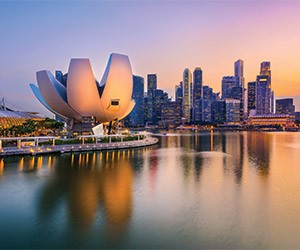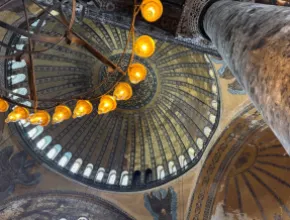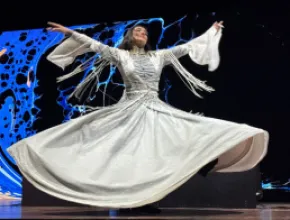Interspersed among Singapore’s ubiquitous glittery glass condos and swank, mini-city-size malls are heritage areas that preserve the diversity of cultures that defines this city-state.
Along with its renowned amenities, that cultural milieu is part of Singapore’s attraction for groups, and those looking to set up a unique experience can contact the Singapore Exhibition & Convention Bureau, a division of the Singapore Tourism Board, for help.
“Face-to-face meetings are now, more than ever, of great significance,” said Kershing Goh, regional director, Americas for the Singapore Tourism Board. “The knowledge exchange, the confluence of diverse ideas and viewpoints from people of different continents, the human interaction, such is the age-old truth of the power of meetings.
“Playing to this backdrop, Singapore’s strength as a meetings destination has never been clearer,” she added. “Ours is a microcosm of cultures that translates into a melting pot of traditions and heritage.”
The diversity is reflected in Singapore’s blend of Chinese, Indian, Malay and other heritages.
“We are truly a country that celebrates diversity and a destination that embraces delegates from all over,” Goh said. “Layer this onto the concentration of colorful experiences that Singapore offers and what you get is the perfect platform for events and meetings.”
Cultural Enclaves
Singapore’s three distinct heritage neighborhoods—Chinatown, Little India and Kampong Glam, or the Arab quarter—offer intriguing allures for groups.
Chinatown, marked by hanging red lanterns and old shophouses, overflows with food hawker centers, traditional markets, and countless trinket-filled tourist stalls.
Its Chinese Heritage Centre, which recently underwent a renovation, offers an interactive experience and full history of Singapore’s Chinese population. Located in three refurbished shophouses dating to the 1950s, the center spotlights migrants’ perilous journeys to Singapore and their contributions to Singapore’s society, as well as the development of modern Chinatown. Groups can organize a private tour of the center.
Journeys Pte Ltd. offers private options for any of its Original Singapore Walks tours, including “Red Clogs Down the Five Foot Way,” which traces the lives of early Chinese immigrants, with stops at Thian Hock Keng temple, a Chinatown wet market and the Chinatown Heritage Centre.
Strolling Arab Street, attendees will find shops hawking batiks and baskets, while on Bussorah Street vendors sell Muslim-inspired crafts and restaurants focus on local cuisine. At the end of the street towers the golden-domed Sultan Mosque, dating to 1924. Colorful Haji Lane, meanwhile draws contemporary shoppers with its fashion boutiques and cafes.
Journeys can organize its “Sultans of Spice” tour for groups, which leads attendees through Kampong Glam, visiting the Sultan Mosque, traditional Muslim shops and the Jalan Kubor Cemetery, the oldest Muslim cemetery in Singapore, featuring graves of Malay royalty, among other stops.
Little India also has its own flavor, including spice stalls and sari shops. But the main draw is the plethora of restaurants representing the entire subcontinent, including a large number of eateries clustered around Sri Veeramakaliamman Temple, one of the oldest temples in Singapore.
According to Thomas Stecher, director of client relations and innovation for Ovation Singapore, the DMC offers groups architectural tours as well as personalized guided cultural tours with a focus on Chinese, Arab, Malay, Indian and Colonial heritages.
PageBreak
The unique Peranakan ethnic group, reflecting the local-born descendants of the Chinese who came to the Malay peninsula between the 15th and 17th centuries, is situated around the Joo Chiat and Katong precincts where many of the shophouses still stand. Singapore’s Peranakan Museum, located in the former Tao Nan Chinese School, built in 1912, explores the culture of Peranakan communities in Southeast Asia. The museum offers space for groups.
Ovation also organizes classes for groups in Peranakan culture, including art, calligraphy and cooking. Small groups can meet at a Peranakan private home. Other Chinese-based options, such as dragon boat or feng shui classes, are also on offer.
For a taste of Singapore’s food culture, “Makan Makan—Let’s Eat,” presented by A+B Edu Tours and Travel Pte., introduces attendees to local cuisines, with stops including the Fort Canning spice garden and the Geyland Serai Market, which focuses on Malay and Indian foods.
Groups are also looking for more “hyper-local” experiences to be integrated into their itineraries, according to the Tourism Board. In response, local providers are creating experiential tours, such as business trips to Singapore’s water treatment plant or to Singapore’s heartlands—areas outside shopping haven Orchard Road or the Central Business District—that give visitors a glimpse into local living.
For a taste of history, companies such as Tour East Singapore offer groups the “Footsteps of Raffles” tour. The 3.5-hour tour begins where Singapore founder Sir Stamford Raffles is believed to have first stepped ashore in 1819, and stops for high tea at the Raffles Hotel before ending with a boat ride down the Singapore River.
The “Historical Singapore Bike Tour” is popular with groups and stops at Chinatown, Kampong Glam, the Museum District, City Hall, Marina Bay and historic Raffles Place, among other locales.
Dabbling in the Arts
Aside from heritage and cultural tours, Singapore’s arts and cultural venues open their doors to groups. National Gallery Singapore recently debuted, and offers private group tours. Meanwhile, the National Museum of Singapore, the nation’s oldest museum, which was refurbished in 2015 for Singapore’s 50-year anniversary, offers space for groups in its Glass Atrium and Gallery Theatre.
Red Dot Design Museum, a collection of more than 1,000 exhibits in the field of product design and communication design from over 50 countries, also welcomes groups.
ArtScience Museum, shaped like an open lotus flower and located in the Marina Bay area, offers more than 32,000 square feet of indoor and outdoor space.
Business at Hand
Singapore’s international appeal and strategic location provide a strong impetus for organizers to hold events there, according to the Tourism Board. Singapore was named Asia’s “Top Convention City” for the 14th consecutive year in 2015, according to the International Congress and Convention Association Global Rankings 2015. It was also the “Top International Meeting City” for the ninth consecutive year in 2015, as documented by the Union of International Associations Global Rankings 2015.
The tourism sector continued to grow from January to September 2016. International visitor arrivals increased 9 percent over the same period in 2015 to reach 12.4 million visitors.
Access is key, as Singapore is linked with more than 100 international airlines flying to some 300 cities in about 70 countries and territories worldwide.
The city-state is also home to large meeting spaces, such as Sands Expo and Convention Centre, Changi Exhibition Centre, Resorts World Sentosa Convention Centre, Suntec Singapore Convention & Exhibition Centre and Raffles City Convention Centre, as well as the grand urban horticultural display of Gardens by the Bay.
Hotel Fever
Ever-expanding hotel inventory in Singapore is rising again this year with a variety of openings. Upcoming hotels include the InterContinental Singapore Robertson Quay, scheduled to debut by September. The 225-room hotel will replace the former Gallery Hotel.
The boutique-style Andaz Singapore, set to debut in late summer, will offer 342 guest rooms and 14,800 square feet of event space. Another upcoming property, the Hilton Garden Inn Singapore Serangoon is slated for a June debut with 328 guest rooms, while an upscale 222-room Sofitel Singapore City Centre will follow in July, including a ballroom for up to 800 theater-style and eight meeting rooms.
Another high-end property, The Duxton Club, A Luxury Collection Hotel, is due to debut in September and will reside in two pre-war Colonial shophouse buildings within walking distance of one another: the Duxton House will feature 50 guest rooms while Duxton Terrace will offer 138 guest rooms. YOTEL is also planning a 2017 opening with 610 “cabins” on Orchard Road, Singapore’s busiest commercial strip.
Recent hotel openings include the 37-room The Warehouse Hotel and 308-room Hotel G Singapore.







